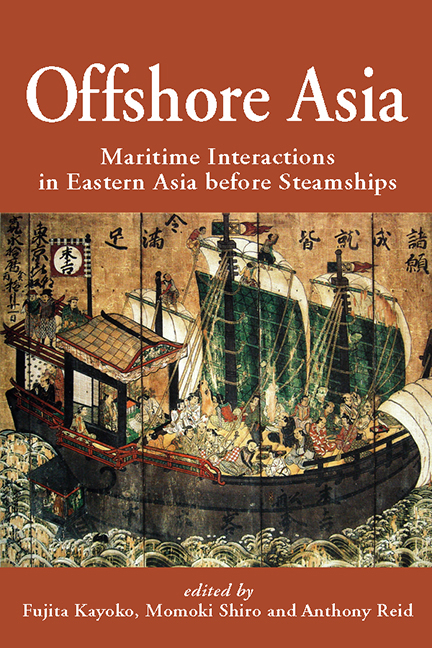Book contents
- Frontmatter
- Contents
- Maps
- Tables and Figures
- Preface
- Contributors
- Map 1 Eastern Asia in the 13th–16th Centuries
- 1 Introduction: Maritime Interactions in Eastern Asia
- 2 The Periodization of Southeast Asian History, in Comparison with that of Northeast Asia
- 3 Merchants, Envoys, Brokers and Pirates: Hokkien Connections in Pre-modern Maritime Asia
- 4 An Asian Commercial Ecumene, 900–1300 ce
- 5 The Japanese Archipelago and Maritime Asia from the 9th to the 14th Centuries
- 6 Saltpetre Trade and Warfare in Early Modern Asia
- 7 Shaping Maritime East Asia in the 15th and 16th Centuries through Choson Korea
- 8 Shipwreck Salvage and Survivors’ Repatriation Networks of the East Asian Rim in the Qing Dynasty
- 9 Wei Zhiyan and the Subversion of the Sakoku
- 10 Metal Exports and Textile Imports of Tokugawa Japan in the 17th Century: The South Asian Connection
- Bibliography of Works Cited
- Index
- NALANDA-SRIWIJAYA SERIES
4 - An Asian Commercial Ecumene, 900–1300 ce
Published online by Cambridge University Press: 21 October 2015
- Frontmatter
- Contents
- Maps
- Tables and Figures
- Preface
- Contributors
- Map 1 Eastern Asia in the 13th–16th Centuries
- 1 Introduction: Maritime Interactions in Eastern Asia
- 2 The Periodization of Southeast Asian History, in Comparison with that of Northeast Asia
- 3 Merchants, Envoys, Brokers and Pirates: Hokkien Connections in Pre-modern Maritime Asia
- 4 An Asian Commercial Ecumene, 900–1300 ce
- 5 The Japanese Archipelago and Maritime Asia from the 9th to the 14th Centuries
- 6 Saltpetre Trade and Warfare in Early Modern Asia
- 7 Shaping Maritime East Asia in the 15th and 16th Centuries through Choson Korea
- 8 Shipwreck Salvage and Survivors’ Repatriation Networks of the East Asian Rim in the Qing Dynasty
- 9 Wei Zhiyan and the Subversion of the Sakoku
- 10 Metal Exports and Textile Imports of Tokugawa Japan in the 17th Century: The South Asian Connection
- Bibliography of Works Cited
- Index
- NALANDA-SRIWIJAYA SERIES
Summary
The inter-Asian emphasis of this volume is part of a welcome reintegration of regional histories following the gains made in area studies in recent decades. Southeast Asianists have paid some attention to the 9th to 14th centuries as a time of state-building, when the so-called charter polities dominated the region. Several Southeast Asianists have also identified a kind of turning point in the 13th or 14th century (see below), and a recent volume has focussed on the 15th century as marking a number of new beginnings for what Anthony Reid called Southeast Asia's “Age of Commerce”. Meanwhile China scholars have had difficulty extending beyond the dynastic periodization of Tang, Song and Yuan, let alone seeing China as part of a broader set of networks. But when we shift the focus to the maritime networks that operated throughout Asian waters, the 9th to 13th centuries can be seen as marking a kind of maritime boom of a broader sort. While the commercial actors in the earlier part of the period were largely West, South and Southeast Asians, the sources from China are indispensable in identifying these networks.
From a background in Middle Eastern History, Janet Abu-Lughod has drawn attention to the last phase of this flowering, though on a basis which appears to need adjusting for eastern Asia (see below). In this chapter it is argued that the entire four centuries from circa 900 to 1300 CE can be seen as a long period of expansion of maritime trade, which in turn induced political, social and economic changes throughout the region. The conjunction of a number of forces provided an environment where maritime trade boomed not only in Southeast Asia, but also in the South China Sea as argued elsewhere in this book. The period 900–1300 indeed has a number of similar features to those identified as marking an “Age of Commerce” for Southeast Asia in the 15th–17th centuries.
The factors giving rise to this flourishing of maritime trade can be grouped under four heads: Chinese economic policies; socio-economic changes in Southern China; the growth of Islamic trade; and Tamil trade networks.
- Type
- Chapter
- Information
- Offshore AsiaMaritime Interactions in Eastern Asia before Steamships, pp. 76 - 111Publisher: ISEAS–Yusof Ishak InstitutePrint publication year: 2013



